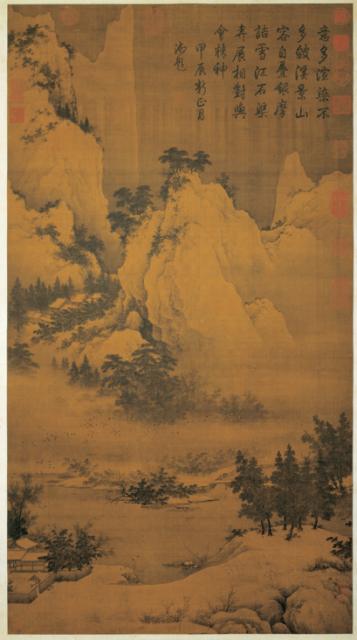宋人溪山暮雪 軸
推薦分享
資源連結
連結到原始資料 (您即將開啟新視窗離開本站)後設資料
- 資料識別:
- 故畫000143N000000000
- 資料類型:
- 類型:繪畫
- 型式:靜態圖像
- 著作者:
- 宋人(Anonymous Song Dynasty)
- 主題與關鍵字:
- 冬景(雪景) 臺閣 橋 江河、湖海 房舍
- 出版者:
- 數位化執行單位:國立故宮博物院
- 格式:
- 本幅 102.1x55.9公分、全幅 91.5公分
- 關聯:
- 石渠寶笈續編(御書房),第四冊,頁1947&*故宮書畫錄(卷五),第三冊,頁117-118&*故宮書畫圖錄,第二冊,頁301-302&*白雪覆蓋溪岸與山峰,群鴉翔集欲歸巢,江天一片寒冬之意。溪山之間,仍見綠樹叢叢寒林不多,應是江南冬日之景象。 從構景來看,本幅仍具「主山立於畫面中央」的遺風,但已脫去山石充實的北宋風格,全幅虛空處幾占有二分之一,顯露出南宋山水的風味。在表現樹石上,繼承李唐 ( 約1049-1130 )之影響,但畫樹與斧劈皴的技法趨於精巧細緻,與馬夏 (活動於十二、三世紀之間 )派傾向粗獷簡逸相異其趣。 本幅描繪景物,細緻生動而且寫實,若將之分割數個方塊來看,正如南宋之山水冊頁。可惜無畫家名款,目前尚難斷定是那位畫院名家之作。( 林柏亭 ) &*1.陳韻如,〈無款溪山暮雪〉,收入林柏亭主編,《大觀- 北宋書畫特展》(臺北:國立故宮博物院,2006年初版一刷),頁121- 123。 2.林柏亭,〈宋人溪山暮雪〉,《故宮文物月刊》,第200期(1999年11月),頁45。 &*臨溪兩岸,竹樹蘢,於平坦處江村置焉。對岸林麓中烘染雲煙如帶,群鴉飛噪於其間,彌增雪意,其上則白山皚皚,冰壑峨峨。於林蒨密處,更著一區精舍。本幅造意之精,構景之妙,可稱獨至。而筆墨細膩,烘染妥帖,尤足以稱其意云。&*此幅標題來自清宮目錄《石渠寶笈.續編》,畫家已不可考,然從風格來看,應屬十二世紀初畫院之作品。 畫中安排與〈谿山行旅〉頗有關連,除前中後三景清晰分割外,山體亦佔畫面三分之二,但已不再營造壯碩之感,而代之以親切與祥和。雖為雪景,但卻生機處處。前景中以細線畫出之低首荷擔旅人,小筆點出之戲水禽鳥等細節,皆引人注目。中景精緻的雲煙霧氣處理,正刻意針對日暮之際;也可與當時畫論對此之關懷相呼應。(20061206)&*The title of this work was given by the editors of the Ch'ing dynasty imperial art catalogue Treasured Artworks of the Stone Moat (Continued). The artist remains uncertain, but judging from the style, it is probably a work of the Painting Academy from the early 12th century. The arrangement here finds a strong correlation with that in Fan K'uan's “Travelers Among Mountains and Streams”, in which the fore-, middle-, and background areas are clearly divided, with the mass of the mountain taking up two-thirds of the painting surface. However, there is no longer a sense of monumentality, but rather one of intimacy and harmony taking its place. Although a snow scene, a sense of life still abounds everywhere here. Particularly noteworthy is the figure in the foreground with head lowered carrying a load and rendered in fine lines and the delicate brushwork that brings out such details as the playful waterfowl. The refined treatment of the clouds and mist in the middleground scenery intentionally hark to the time of day as dusk. This concern for detail in both overall and specific aspects of the landscape is echoed in painting theories of the day.(20061206)&* 白雪覆蓋溪岸與山峰,群鴉翔集欲歸巢。溪山之間,仍見綠樹叢叢,應是江南冬日之景象。從構景來看,本幅仍具「主山立於畫面中央」的遺風,但已脫去山石充實的北宋風格。全幅虛空處幾占有二分之一,顯露出南宋山水的韻味。在表現樹石上,繼承李唐之風格,但畫樹與斧劈皴的技法趨於精巧細緻,與馬夏(活動於十二、三世紀之間)派傾向粗獷簡逸作風大異其趣。(20120103)&* White cloudy mists cover riverbanks and envelope mountain peaks as flocks of jackdaws gather in the sky as they return to roost. Amongst the waters and peaks are still some green forests with a few wintry trees, suggesting a Jiangnan winter’s day. The work reveals traces of the “main central mountain” composition. However, it already departs from the Northern Song style full of mountains and rocks, with void taking up nearly half of it to reveal a Southern Song style. Judging from the trees and rocks, it follows the influence of Li Tang (ca. 1070-1150), but the painting of trees and technique of “axe-cut” texture strokes tend to be finer, unlike the coarser and more abbreviated manner of the Ma Yuan and Xia Gui (fl. 12th-13th c.) school.(20120103)
- 管理權:
- 國立故宮博物院
授權聯絡窗口
- 國立故宮博物院圖像授權、出版授權、影音資料授權-申請流程說明
http://www.npm.gov.tw/zh-TW/Article.aspx?sNo=03003061






